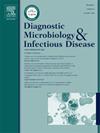Description of blaKPC-carrying Escherichia coli in patients from a Brazilian hospital over a 4-year period
IF 2.1
4区 医学
Q3 INFECTIOUS DISEASES
Diagnostic microbiology and infectious disease
Pub Date : 2025-04-05
DOI:10.1016/j.diagmicrobio.2025.116833
引用次数: 0
Abstract
Klebsiella pneumoniae carbapenemase (KPC)-producing Escherichia coli are recognized by the World Health Organization as a critical group of bacterial priority pathogens of public health importance. Thus, increased understanding of the genetic characteristics of KPC-producing E. coli is required. Here, we performed a retrospective study in a Brazilian teaching-hospital to describe the genomic features linked to antimicrobial resistance, virulence, and phylogeny of 40 meropenem-resistant E. coli. All isolates carried the blaKPC-2 gene, but amikacin, tigecycline, colistin, polymyxin B, and fosfomycin showed good activity. Molecular typing by MLST revealed 20 sequence types (STs), with a predominance of ST131. Whole-genome sequencing identified Tn4401 as a mechanism responsible for blaKPC-2 mobilization, a variety of antimicrobial resistance and virulence genes, the predominance of pathogenic phylogroup lineages, and the grouping of genomes belonging to the same ST. KPC-producing E. coli is not a common pathogen, but few treatment alternatives are available against potentially virulent strains.
求助全文
约1分钟内获得全文
求助全文
来源期刊
CiteScore
5.30
自引率
3.40%
发文量
149
审稿时长
56 days
期刊介绍:
Diagnostic Microbiology and Infectious Disease keeps you informed of the latest developments in clinical microbiology and the diagnosis and treatment of infectious diseases. Packed with rigorously peer-reviewed articles and studies in bacteriology, immunology, immunoserology, infectious diseases, mycology, parasitology, and virology, the journal examines new procedures, unusual cases, controversial issues, and important new literature. Diagnostic Microbiology and Infectious Disease distinguished independent editorial board, consisting of experts from many medical specialties, ensures you extensive and authoritative coverage.

 求助内容:
求助内容: 应助结果提醒方式:
应助结果提醒方式:


